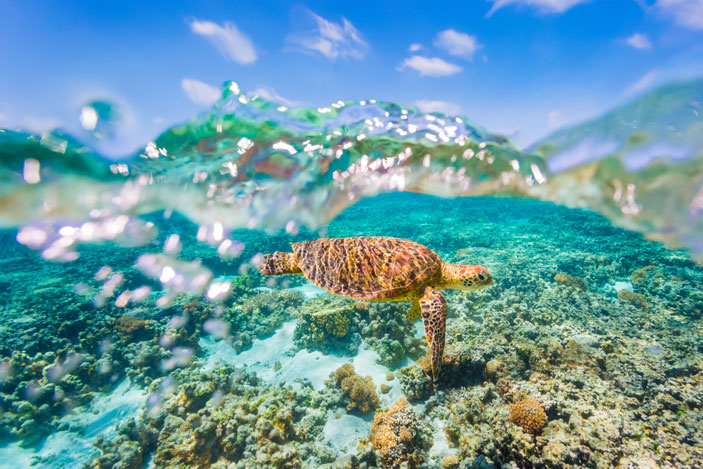10 Fascinating Facts About the Great Barrier Reef
The Great Barrier Reef, an icon of marine biodiversity, sprawls over 344,400 square kilometers, making it the largest coral reef system on the planet. This wonder, visible from outer space, is not merely a stunning visual spectacle but a crucial component of Earth’s ecological balance. Below, we explore ten captivating facts that reveal the intricate layers of this natural marvel.
Situated off the northeastern coast of Australia, the reef boasts a staggering array of marine life. It is home to more than 1,500 species of fish, over 400 types of coral, and countless invertebrates such as starfish, sea urchins, and mollusks. The biodiversity is not just remarkable; it is critical to sustaining the delicate ecosystem that thrives in these waters. In its complexity, each organism plays a pivotal role, contributing to self-sustaining habitats and food webs.
Notably, the Great Barrier Reef is a UNESCO World Heritage Site. Designated in 1981, this classification underscores its significance not only as an ecological treasure but also as a cultural one. The reef holds sacred importance for Indigenous Australian communities, including the Torres Strait Islanders and Queesland’s Aboriginal groups, who have inhabited the region for thousands of years. Their deep spiritual connection with the sea and the unique ecosystems within it emphasizes a rich tapestry of cultural heritage that extends beyond scientific understanding.
Climate change poses one of the gravest threats to this fragile ecosystem. Rising ocean temperatures have led to widespread coral bleaching—a phenomenon where corals expel the symbiotic algae called zooxanthellae, leading to a decline in health and vitality. Scientific predictions suggest that without substantial action to mitigate climate change, the Great Barrier Reef could suffer irreversible damage within the next few decades.
Yet, the reef flourishes in more ways than one. It serves as an underwater nursery for various species, providing breeding and feeding grounds critical for marine life. Marine turtles, for example, rely on the reef for nesting, while juvenile fish seek refuge among coral crevices. This protective environment is essential for the survival of many species, further emphasizing the interconnectedness of life within marine ecosystems.
Besides its ecological importance, the Great Barrier Reef is a hub for recreational activities and a key economic driver. The tourism sector thrives on its natural beauty—drawing millions of visitors each year eager to experience diving, snorkeling, and sailing. This influx of tourists leads to significant financial contributions to the local economy, but it also necessitates sustainable practices to prevent degradation. Ongoing efforts by the government and non-profit organizations aim to balance economic benefits with conservation needs.
Marine research flourishes within the Great Barrier Reef Marine Park, established to protect its myriad ecosystems. Researchers employ cutting-edge technology, including underwater drones and satellite imagery, to study the complexities of coral health, fish populations, and the effects of climate change. The findings not only amplify understanding but also inform conservation strategies, exempting the reef from further jeopardy.
Another remarkable aspect of the Great Barrier Reef is its geological history, dating back over 20 million years. Over time, the region has undergone significant transformations, shifting from a tropical sea to a vibrant ecosystem teeming with life. The ongoing evolution of the coral structures is influenced by environmental conditions and geological events, showcasing nature’s resilience and adaptability.
Distinctively, the Great Barrier Reef includes various ecosystems, ranging from deep-sea environments to shallow lagoons. Each of these habitats supports a unique set of organisms, highlighting the diversity found within the reef itself. For example, seagrass meadows serve as vital feeding grounds for endangered species such as dugongs and provide nursery habitats for numerous fish species.
In conclusion, the Great Barrier Reef is not merely a singular entity, but a complex amalgamation of life, history, culture, and economy. Understanding its multifaceted nature enhances our appreciation for this exceptional ecosystem and underscores the importance of protecting it for future generations. As stewards of the Earth, recognizing the intricate relationship between humanity and the natural world is imperative to ensure the continued vitality of such a wondrous phenomenon.
You May Also Like
Best Fish to Catch in Australia: A Guide for Anglers
Australia boasts an extraordinary diversity of fish species, making it …
Emily Bay Norfolk Island: A Hidden Gem in the Pacific
Emily Bay, a picturesque enclave nestled on the sun-kissed shores of …
Holidays on August 23: Global Festivities & Observances
August 23 is a date that carries a bouquet of cultural significance …





